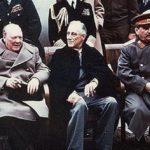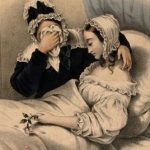 Mysteries
Mysteries  Mysteries
Mysteries  History
History 10 Surprising Stories About the Texas Rangers
 Humans
Humans 10 Philosophers Who Were Driven Mad by Their Own Theories
 Miscellaneous
Miscellaneous 10 Video-Game-Worthy Weapons and Armors from History
 Weird Stuff
Weird Stuff 10 Psychics Who Accurately Predicted Wartime Events
 The Arts
The Arts 10 Pieces of Art Inspired by a Broken Heart
 Health
Health 10 Science Fiction-Sounding New Medical Treatments
 History
History 10 Surprising Facts About the Father of Submarine Warfare
 Space
Space Ten Astonishing New Insights into Alien Worlds
 Weird Stuff
Weird Stuff 10 Bizarre Summer Solstice Rituals Still Practiced Today
 Mysteries
Mysteries Top 10 Haunting Facts About the Ghost Ship MV Alta
 History
History 10 Surprising Stories About the Texas Rangers
 Humans
Humans 10 Philosophers Who Were Driven Mad by Their Own Theories
Who's Behind Listverse?

Jamie Frater
Head Editor
Jamie founded Listverse due to an insatiable desire to share fascinating, obscure, and bizarre facts. He has been a guest speaker on numerous national radio and television stations and is a five time published author.
More About Us Miscellaneous
Miscellaneous 10 Video-Game-Worthy Weapons and Armors from History
 Weird Stuff
Weird Stuff 10 Psychics Who Accurately Predicted Wartime Events
 The Arts
The Arts 10 Pieces of Art Inspired by a Broken Heart
 Health
Health 10 Science Fiction-Sounding New Medical Treatments
 History
History 10 Surprising Facts About the Father of Submarine Warfare
 Space
Space Ten Astonishing New Insights into Alien Worlds
 Weird Stuff
Weird Stuff 10 Bizarre Summer Solstice Rituals Still Practiced Today
10 Female Film Pioneers Who Shaped the Movies
Since the earliest days when the new-fangled movie industry was inventing itself, talented women have played significant roles in developing both the art and craft of telling stories on the screen, breaking new ground, and defying gender norms along the way. Many who were artistically and technically influential in their time are all but forgotten today. This covers just ten of these great women and their contributions to the movie industry a century ago.
Related: 10 Golden Hollywood Scandals That Were Covered Up
10/span> Alice Guy Blaché (1873–1968)
In 1896, Alice Guy was hired as a secretary for Gaumont, a French company that manufactured motion picture cameras and projectors. Soon, Gaumont began to make its own movies, and she became the world’s first credited female director. Thanks to the quantity and quality of her films, by 1905, she was supervising Gaumont’s other directors and turning out increasingly ambitious movies herself.
At a time when scenes were often staged like plays and shot by a stationary camera, her thirty-three-minute spectacle La Vie du Christ (The Life of Christ, 1906) featured twenty-five sets, exterior locations, over three hundred extras, and the then-novel technique of panning the camera across the action. After she married Herbert Blaché, the couple moved to the United States, where she set up her own studio in what was then the center of American movie production: New Jersey.
Over two decades, Guy Blaché made more than four hundred silent films, including feature-length melodramas, comedies, and action movies, alternating duties as director or producer with her husband. Her business flourished until infringement lawsuits brought by the Edison Trust, which controlled patents related to filming, prompted her to join other moviemakers who fled to sunny Southern California. There, she worked as an assistant director on a few of her husband’s films, but she never shot another movie of her own.[1]
9 Germaine Dulac (1882–1942)
The word auteur could have been coined to describe Germaine Dulac, France’s second female director, who laid the groundwork for the experimental cinema of the next generation. In 1915, she switched from writing theatre and movie reviews for a feminist magazine to making imaginative and daring movies of her own.
Throughout her more than two dozen silent films, she focused primarily on the expression of emotion through atmosphere, which she achieved through creative lighting, camera angles, and editing. Her surrealistic portrayal of a priest’s sexual fantasies in La Coquille et le Clergyman (The Seashell and the Clergyman, 1928) prompted the British Board of Film Censors to ban it, stating, “If this film has a meaning, it is doubtless objectionable.”
Dulac was made an Officer of the French Legion of Honor in 1929 in recognition of her contributions to the movie industry. However, her highly visual dramatic style did not transition well into talkies. During the 1930s, she made documentaries and newsreels, choosing personal, everyday subjects in keeping with her desire to promote understanding among people. Under Nazi censorship during World War II, her publication of film theory and criticism ended. Still, she used her influence in the field to ensure that many seized movie prints were preserved.[2]
8 Lois Weber (1879–1939)
Director-producer-writer-actress Lois Weber was a creative hyphenate long before that term existed. From 1911 to 1914, she made more than eighty short films, including Suspense (1913), which used innovations such as close-ups and three-way split screens to build tension and show simultaneous action.
Weber was the first American woman to direct a full-length feature with The Merchant of Venice (1914), in which she also starred as Portia. Within two years, she was the highest-paid director in the world, praised by critics and packing theaters in New York City at one dollar per ticket.
Weber was bold in both her imagery and subject matter, tackling themes including abortion, prostitution, and birth control. In Hypocrites (1915), she used double exposure to make a statue representing Naked Truth morph into a naked woman—or so it appeared. Where Are My Children? (1916) was banned in Pennsylvania as “not fit for decent people to see.” But it was a box office hit elsewhere.
However, as the Great Depression deepened and interest in socially conscious films waned, her production company failed. She made her last movie, and only talkie, in 1934.[3]
7 Elinor Glyn (1864–1943)
This English novelist did not invent sex appeal, but she proved it could sell. After publishing a string of scandalous—and wildly popular—romance novels about the upper class, Elinor Glyn brought her talents to Hollywood in 1920 under a contract worth £10,000 (equal to more than $692,000 in 2023). Over the next several years, she adapted some of her biggest-selling books for the screen, including Three Weeks (1924), His Hour (1924), and Man and Maid (1925).
Glyn contributed to both film history and the language with the release of It (1927), starring Clara Bow, who became known as the “It Girl.” Writing in Cosmopolitan magazine, Glyn defined “It” as “that quality possessed by some few persons which draws all others with its magnetic life force.” For enthusiastic movie-goers during the Roaring Twenties, “It” came to mean sex. The film’s success demonstrated that “It” meant big box office.[4]
6 Mabel Normand (1892–1930)
Mabel Normand made audiences laugh from both sides of the camera. After working as an artist’s model and movie extra, in 1912, she joined forces with Mack Sennett, creator of the Keystone Kops, and became a fan favorite with her signature style of physical comedy. Normand starred in more than two hundred short films and developed her own brand in popular fare, such as Mabel’s Stratagem (1912) and Mabel’s Awful Mistake (1913).
Normand also directed ten films, including Mabel’s Strange Predicament (1914), in which Hollywood newcomer Charlie Chaplin introduced his character of the Little Tramp. Sennett would later state that Chaplin learned to direct from Normand. The same year, she co-starred with Chaplin in Tillie’s Punctured Romance, the first American feature-length comedy.
Despite this string of success, Normand’s career took a hit in the mid-1920s from bad publicity due to her perceived association with high-profile scandals: the Fatty Arbuckle rape case, the murder of a close friend of hers, and a shooting by her chauffeur. In the last days of silent films, she died of tuberculosis at age thirty-seven.[5]
5 June Mathis (1887–1927)
The influence of June Mathis was not limited to the more than one hundred silent films she wrote herself. By 1920, she was the head of the scenario department at Metro Pictures (later to merge with Goldwyn Studios to become MGM) and its only female executive. Her powerful position gave her oversight of scripts, activities on set, and editing decisions—the equivalent of a modern-day producer—on movies, including Elinor Glyn’s Three Weeks.
With a keen eye for future stars, she cast Buster Keaton in his first feature-length film (The Saphead, 1920) and gave Rudolph Valentino his breakout role in The Four Horsemen of the Apocalypse (1921), the year’s top-grossing film.
Mathis went on to write Camille (1921) and four more lead roles for Valentino, as well as Ben-Hur: A Tale of the Christ (1925) for Ramon Novarro. These cemented her position as a major Hollywood player. Her career was cut short when she suffered a fatal heart attack at age forty.[6]
4 Mary Pickford (1892–1979)
Canadian-born child actress Gladys Smith grew up to be America’s Sweetheart, Mary Pickford. Even when early silent films did not credit the names of performers, Pickford’s on-screen charm stood out, making her one of America’s first movie stars. In 1912, she graced the cover of the debut issue of Photoplay magazine. Five years later, she signed a contract that paid her $350,000 (more than $8.1 million in 2023) for each of three films.
But Pickford was more than just a pretty face under girlish curls, and she used her wealth and star power to shape her fledgling profession. Seeking to retain greater creative and financial control, she joined with actor Douglas Fairbanks Sr., director D.W. Griffin, and Charlie Chaplin to form United Artists studio in 1919, where she often served as producer on her films.
Pickford was also among the founders of the Academy of Motion Picture Arts and Sciences, the Motion Picture Relief Fund to aid industry workers in need, and the Society of Independent Motion Picture Producers, which challenged studio monopolies. The Academy recognized Pickford as Best Actress for Coquette (1929), her first sound picture. In 1976, she received an Honorary Oscar “In recognition of her unique contributions to the film industry and the development of film as an artistic medium.”[7]
3 Dorothy Arzner (1897–1979)
Dorothy Arzner began by typing movie scripts and worked her way up to reader, cutter, and editor. Her skill and ingenuity in adding stock footage of bullfight scenes to Valentino’s Blood and Sand (1922) helped pave the way for her to become the only female director working within the studio system. Arzner was also the rare female director to successfully make the transition from silents to sound. For The Wild Party (1929), she deployed the first boom microphone by putting the mic on a long pole held high above camera range, improving the audio quality and giving actors greater freedom of movement.
In 1933, Arzner joined the newly formed Directors Guild of America and remained its only female member until Ida Lupino was admitted in 1950. In more than twenty films over two decades, Arzner was known for telling stories about complex, independent women portrayed by A-list stars, including Katharine Hepburn, Joan Crawford, Rosalind Russell, and Claudette Colbert. During World War II, she made training films for the Women’s Army Corps. She later taught filmmaking at UCLA.[8]
2 Marion Fairfax (1875–1970)
After enjoying modest success as a playwright, Marion Fairfax headed west to write for the screen in 1915. Her forty-nine films ranged from comedy to drama, including vehicles for stars like Mary Pickford, John Barrymore, Norma Talmadge, and Dorothy Gish. She also directed her script for The Lying Truth (1922), which dealt with the controversial topics of drug addiction, the evils of mob justice, and the rights of unionized miners.
Fairfax followed the success of Sherlock Holmes (1922) with The Lost World (1925), based on another work by Sir Arthur Conan Doyle and one of the highest-grossing films of its year. In addition to writing the script, she oversaw editing, titling, and production for this first feature-length use of stop-motion animation that created the most lifelike prehistoric beasts audiences had ever seen.
While under contract to First National Pictures (later to become Warner Bros.), her influence extended beyond her own movies, as she was frequently consulted regarding the quality of other projects in production. She retired in 1926, perhaps due to ill health, yet lived another four decades.[9]
1 Frances Marion (1888–1973)
As silent films matured, the writer’s job progressed from creating rough scenarios to composing title cards with increasingly sophisticated dialogue and narration. Former journalist Frances Marion learned filmmaking as an assistant to Lois Weber. Her scripts attracted the attention of Mary Pickford, and she became Pickford’s favorite screenwriter and lifelong friend. Their films together included Rebecca of Sunnybrook Farm (1917), A Little Princess (1917), and The Love Light (1921), which Marion also directed at Pickford’s insistence. By 1926, Marion was earning $3,000 per week (almost $50,000 in 2023) for both adaptations and original stories.
When movies began to talk, Marion supplied the words. She wrote Greta Garbo’s first spoken lines in Anna Christie (1930) and won Academy Awards for The Big House (1930) and The Champ (1931). Her enduring legacy includes Dinner at Eight (1933), the Shirley Temple vehicle Poor Little Rich Girl (1936), and The Good Earth (1937).
Marion also literally wrote the book on her craft, How to Write and Sell Film Stories (1937). As the power of the big corporate studios increased and Marion’s creative control was reduced, she broke her contract with MGM and became a freelancer. In her autobiography, Off with Their Heads! A Serio-Comic Tale of Hollywood (1972), Marion stated, “I hope my story shows one thing—how many women gave me real aid when I stood at the crossroads.”[10]








